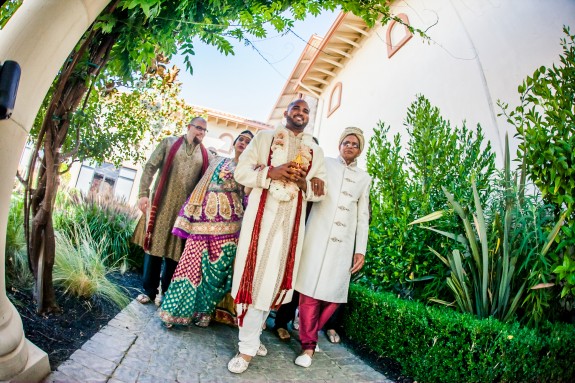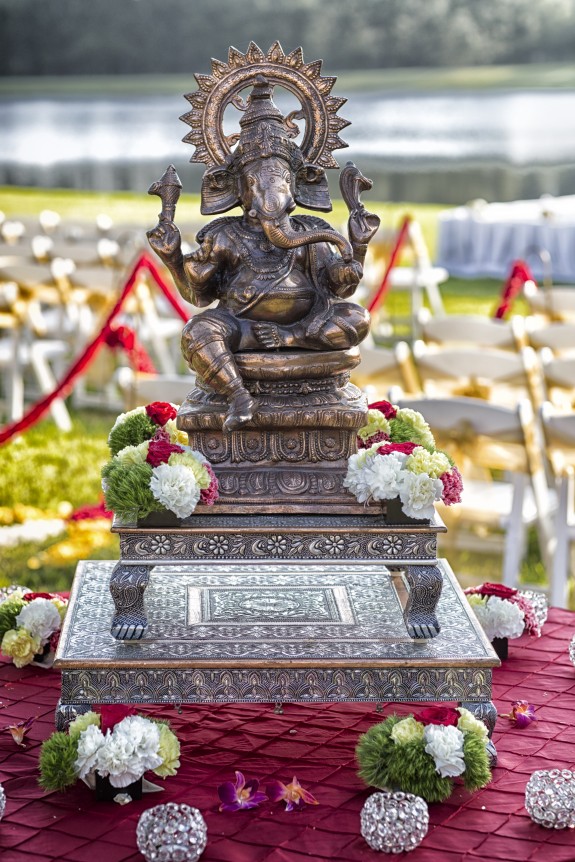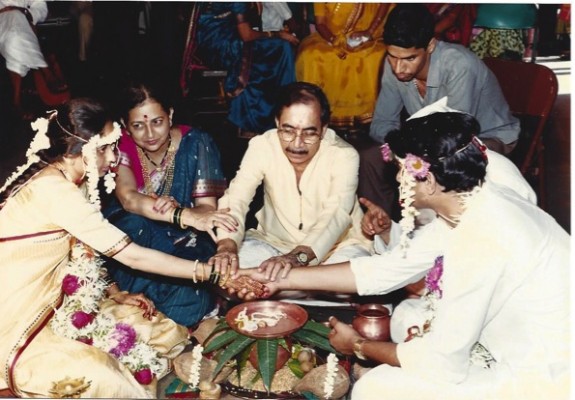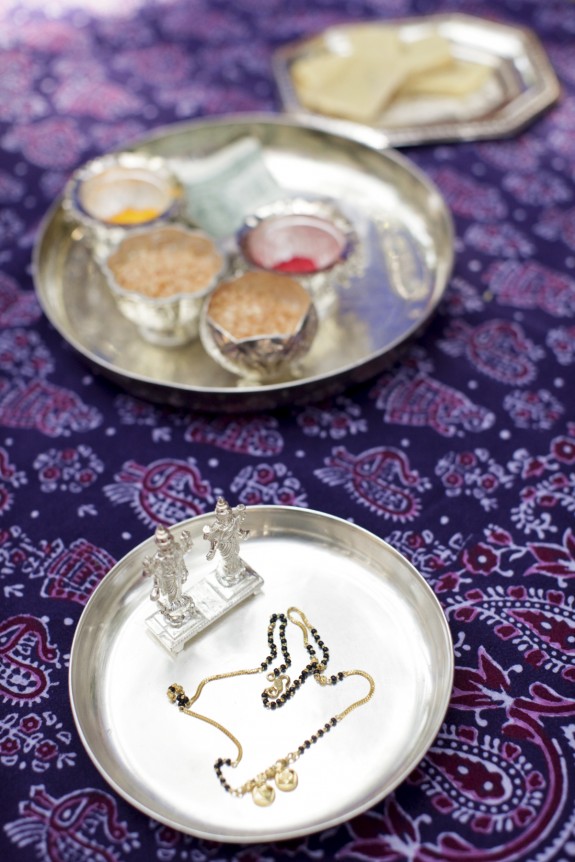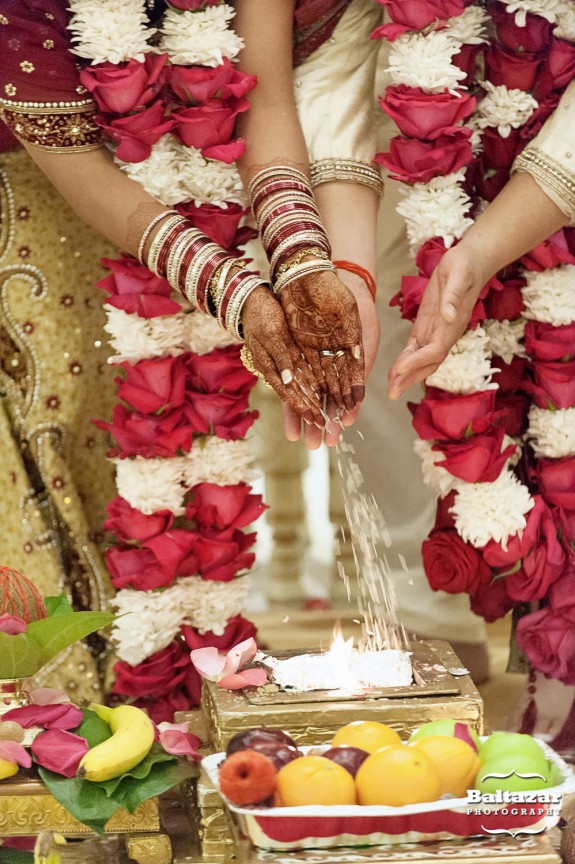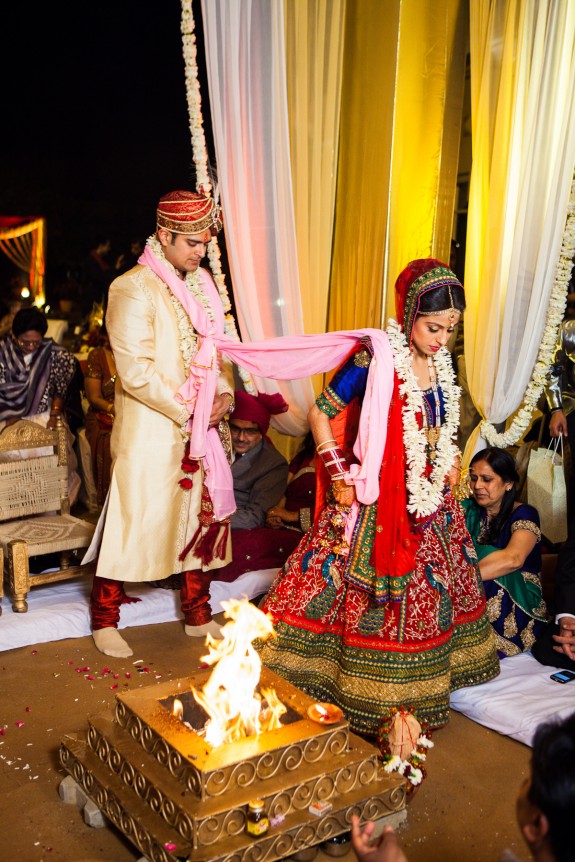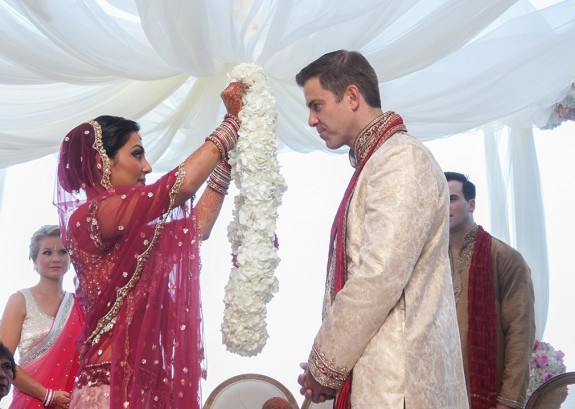A CKP wedding ceremony starts early in the morning and runs until late afternoon. In a very traditional manner, the bride’s family hosts the groom’s family at a venue – which is usually the reception hall of a temple.
View the rest of the CKP Wedding Guide:
Pre-Wedding/Engagement Rituals
Wedding Rituals – You are here!
The bride’s family arrives early in the morning to set up the venue to welcome the groom’s family. When the groom’s side of the family (Barati) arrives, they are welcomed by the entire bride’s family waiting outside.
Photo via Tanvi & Shyam’s Wedding
The bride’s mother washes the groom’s feet with water and applies a tikka to his forehead. This symbolizes her care and protection for him as a son. The groom’s family is welcomed with an arti and sweets as well.
Once inside the venue, the bride and groom are seated on chairs. The groom is gifted jewelry and clothing by the bride’s father. The groom is then given sweet kesar (saffron) milk to drink from a silver cup. He drinks half and gives the rest to the bride, symbolizing a future of sharing everything together.
Ganpati Puja
The CKP community feels very close to Lord Ganesh, who represents bravery and strength in the ancient warrior caste. Before the wedding ceremony commences, a prayer for Ganesha’s blessings upon the marriage and the wedding is said.
Photo via Priyanka & Sandesh’s Wedding
Punyavachan
After the priests leads the prayers for Lord Ganesha, he invites the parents of the bride and the groom to pray for the well-being and happiness of their children. The priest recites the Punyavachan prayers.
Photo via Suwarna and Milind’s Wedding
Both sets of parents wear the Pavitrakas (rings made of metal) and sip blessed water while reciting achamana prayers. The achamana prayers worship all the Gods by repeating their names. After the prayers are completed, the parents practice udaka, which is allowing the blessed water to pass through their right palms. This signifies the end of the ritual.
Sankalp
The groom affirms his desire to marry by requesting the priest’s blessings to lead a grihasti (householder and caretaker’s lifestyle). The bride and the groom then request the blessings of their elder family members, who in turn bless them and give them more gifts of jewelry and clothes.
The bride’s and the groom’s parents officially greet each other by enjoying madhuparka together with the bride and the groom. Madhuparka is a fruit dessert with honey, ghee, and yogurt.
The bride’s father places his daughter’s hand in the hand of the groom, blessing them with a happy married life. The bride’s mother pours blessed water over their palms. This ritual symbolizes the father giving away his daughter to marriage. The groom accepts this proposal by gently placing his hand on the bride’s shoulder. After this acceptance, the bride’s father pours the blessed water over the groom’s palm, symbolizing that his daughter now belongs to the groom.
Akshataropanam
The bride and the groom express their desire to marry each other and pledge to be faithful and caring towards one another. They express emotions such as prosperity, success, sacrifice, and righteousness. Each time they express a virtue, their family members sprinkle them with rice and bless that their desires be fulfilled.
Mangulsutra Bandhan
This ritual is the tying of the mangulsutra, a gold necklace that is worn by married women. The groom ties the mangulsutra around the bride’s neck and she in turn ties a gold chain around the groom’s neck. The groom then applies a kumkum of haldi on the bride’s forehead, and the bride applies a tikka of sandalwood paste to the groom’s forehead.
Photo via Chethana & Eric’s Wedding
The bride’s mother-in-law gifts her a green silk sari, silver toe rings, and some cosmetics as her welcome into the family. The bride changes into this new sari, symbolizing her transition to the groom’s family. The bride also wears a shela, a shawl draped around her shoulders, which is tied by the groom’s sister (or female relative close to his age). The shela is further tied to the groom’s uparna (cloth draped over his kurta and dhoti).
Paanigrahan
The bride and the groom hold hands and exchange vows of honor and marriage to each other. The groom promises to care for her and treat her properly. He promises to uphold his duties as a husband and householder.
Vivah Homa
This ritual is the offering for the wedding ceremony. The priest arranges this offering by lighting a fire (yajoka) in the wedding altar, and the couple sits by it. To the west of the fire, a stone is kept to symbolize strength and resolve. To the east, an urn filled with water (to represent nourishment) is kept. Four blades of grass are spread to the north of the fire. Two metal bowls, one filled with water and another filled with melted ghee, are placed on these blades of grass.
The groom dips the blades of grass in the water and sprinkles them and the ghee into the fire. This action symbolizes purity in the marriage. He offers the grass in the name of Skanda, the hero god. He also pours some of the ghee into the fire as a sacrifice to Prajapati, the god of creation.
Pradhanahoma
The groom makes his final offering into the fire: his prayers and obligations to his wife and his gods. He tosses ghee into the fire as he makes these, wishing for a safe and happy life for himself and his wife.
Lajahoma
The priest places ghee and puffed rice into the bride’s cupped palm. The bride recites mantras, and after each, she transfers the mixture from her hand to the groom’s, who then tosses it into the fire. The groom then wishes for the fire to grant his bride the power to strengthen her ties with her new marital family.
Photo via Puja & Nicholas’ Wedding
Parinayam
The groom takes the bride’s hand and walks one round around the fire and the urn of water.
Ashmarohsch
The bride is asked to touch a grinding stone with her foot, praying to be as strong and resolute as the stone. Rice is thrown into the fire as the bride completes this ritual thrice.
Photo via Diana & Andrew’s Wedding
This ritual is the ceremonial walking around the fire, unifying the couple in the bond of marriage. The groom takes the bride’s left hand in his right hand and takes seven rounds around the fire. Mantras are chanted as each step is taken by the couple. The bride and the groom step on a heapful of rice at each step, spaced around 2 feet apart.
Photo via Chhavi & Saurabh’s Wedding
This ritual symbolize each stage in the married couples’ lives, which they take together. At the end of the ritual, the groom chants to the fire and takes a large container of water (praneetapatra). He slowly extinguishes the fire with the praneetapatra, and the leftover water is sprinkled all over and on the heads of the bride and the groom. The groom takes some of the ashes from the extinguished fire and applies them to his bride’s forehead.
Laxmi Puja
A puja to the goddess Laxmi is practiced at the marriage altar to welcome the new Laxmi (the bride) into the groom’s home. This ritual symbolizes the bride’s official transition from her own family to her husband’s. The groom writes the bride’s name on a plate of raw rice in front of the fire. In more traditional times, he would write the new first name that he would like to call his bride by. However, this practice is now outdated and the groom now simply writes his wife’s real name in the rice.
Karmasamapti
The bride’s father ends the ceremony by taking a spoonful of water and pouring it over his right palm, chanting a mantra to bless his daughter in her new married life. The bride and the groom also follow suit and pour water over their right palms to thank the gods.
Lagna Muhurat
The priest chants mantras while the bride, the groom, and their families sing marital hymns. Akshata (rice grains mixed with kumkum) is tossed over the bride and the groom as blessings are shouted. The bride and the groom stand over the mandap (the raised platform where the ceremonies were conducted) and are separated by a long piece of cloth (antarpat) so they face, but cannot see, each other. The priest chants the last lines of the mangalashtaka (Marathi ceremonial hymns recognizing the marriage) and the antarpat is lowered. The bride and the groom place garlands of flowers around each other, symbolizing the official beginning of their marriage.
Photo via Vanita & Brian’s Wedding
The sisters of the bride and the groom stand behind the couple and sprinkle them with water held in mango leaves. An arti for the newlyweds is performed and sweets are distributed amongst the guests to celebrate their vows. Ladies apply haldi-kumkum to each other’s foreheads.

